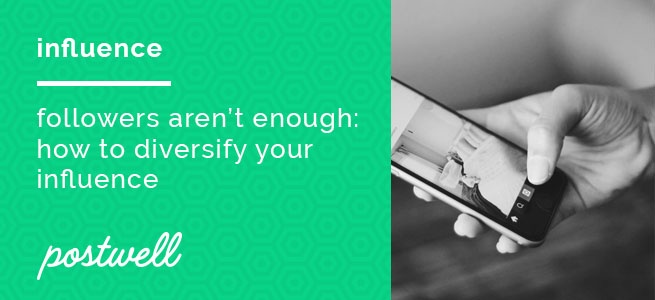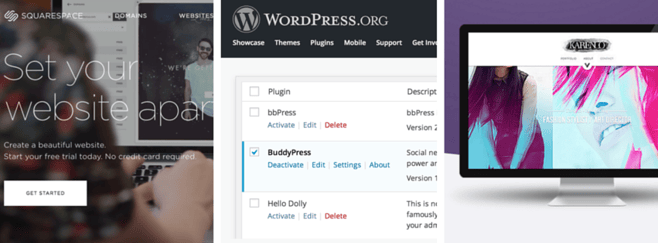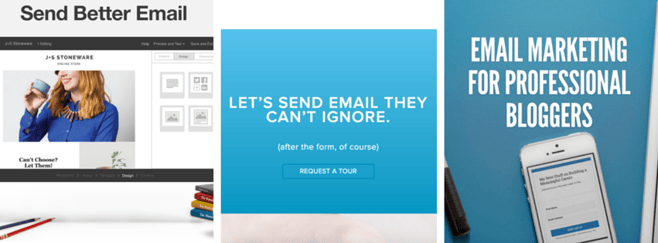
If you’ve got thousands of followers on YouTube or Instagram or Snapchat, it’s hard to see why you need to do anything else. Have a website? Why?
The problem with relying on social media as the sole driver of your business, and it being the only place your audience can find you, is that this makes your audience “rented,” not owned. This is a huge problem if you want to turn your social media influence into a sustainable business. If Instagram changes their algorithms, YouTube changes their subscriber methods, or Snapchat suddenly becomes “pay to play” for brands and influencers, your business has just disappeared.

Even if people just stop using Instagram (or whatever network you rely on), your way of keeping in touch with them and marketing to them is gone.
So how do you diversify your influence and start creating a stronger business?

Step One: Create a website
First off, you need to create an online homebase — your website — that’s a “hub” for all of your activity. Right now, you just want to get something up that looks good, even if it only has links to your social profiles and an about page.
There are a lot of options for building a website, depending on what you want:
- Squarespace is popular for ease of use — everything from domain registration to hosting to website building is included in their monthly subscription fee
- WordPress is more powerful than Squarespace, but requires a little bit more technical skills and has a slightly steeper learning curve
- Other options include Strikingly and Wix — check out this list for more suggestions and a breakdown of each
If you’re struggling to choose a domain name, you can always go with firstnamelastname.com, or use your most popular social media handle (for example, if your Instagram tag is @cleanskinjen, then cleanskinjen.com). Try to make it short, memorable, and something that people who already follow you will be able to find easily.
Okay, you’ve reserved your domain name, you’ve used one of the quick-start templates or free themes from your website builder of choice to make your site look good— now what?
For right now, all you need to add is:
- Links to your most popular social profiles
- A few lines about who you are and what you do (here’s a few tips on how to write a good bio for your website)
- A way to sign up for your email list — which brings us to...

Step Two: Create an email list
By creating an email list and giving people a reason to sign up for it, you’re creating an “owned” audience — one that won’t disappear, no matter what happens. While social media platforms come and go, email isn’t disappearing any time soon.
First, you’ll want to pick an email marketing provider. MailChimp is a very popular choice, due to its ease of use and the free plan option. Other options include Aweber, ConvertKit, Emma, and MadMimi. Compare prices and features, and see which one works best for you. Don’t worry too much about it right away — you can always switch later, and you’ll be able to export your email list so that you won’t lose any emails.
Then, you’ll decide what to send your subscribers. You can create a free course or ebook later, if you want, but for right now, you can just start sending newsletters. Decide how often you want to send (weekly, every other week, etc.), and then figure out what you want to include in it. Weekly is a good place to start, but more important than how often you’re sending it is sending it regularly. It’s better to have a consistent, biweekly newsletter than an inconsistent newsletter that’s supposed to be weekly.
A few examples of you can include in your newsletters are:
- Links to your most popular videos/photos/posts of the week
- Links to a post you read, a movie you saw, etc. — things you enjoyed that your subscribers might also enjoy
- Teasers for upcoming posts, like a link to a product you’re getting ready to review and one or two preliminary thoughts
The last thing you’ll want to do, after you’ve created a list and a schedule for your newsletter, is to make sure people can sign up for it on your website. Your email marketing provider should have tips in their FAQ or knowledgebase on how to set up a signup form, and if not, their customer service can walk you through it.

Step Three: Create a marketing plan
This can be the most time-consuming step, and is actually something you’ll be working on over time. Don’t feel like you have to create a comprehensive two-year marketing plan or anything like that. Essentially, what you’re doing is creating a list of ways that you can bring people back to your website and grow your email list, while also creating more business opportunities for yourself.
Here are some ideas to get you started:
- Make sure your website link is included in all of your social profiles
- Referring back to your website regularly and creating things to draw your social media followers back to your site (whether that’s blog posts with notes to go with a video, a free video series delivered by email, or something else)
- Posting about your newsletter and prompting people to sign up
- Creating a media kit and posting about it on your social channels to drive sponsorship
It might seem like a lot of work now, but creating an online home-base and diversifying your influence is a smart move in the long run. You’ll get more sponsorships, have more opportunities to promote affiliate products, and you’ll know that you have a solid business — even if Instagram does disappear tomorrow.

